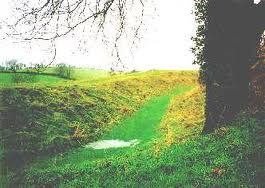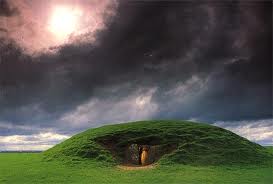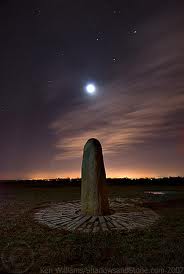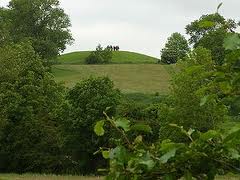Celtic Conundrum.
It was during the Iron Age that Celtic culture was first introduced to Ireland. There were both similarities and differences between Irish Celtic culture and continental cultures of that period. Archaeology and history combine to give us a vivid picture of the Continental Celts but is that picture accurate when it comes to Ireland? Were the Irish really part of that culture?
It must be remembered that there were two different Celtic cultures coming from Western Europe during the Iron Age, the Hallstatt Celts, the earlier ones and the La Tène Celts who arrived much later. There is little evidence of the Hallstatt Celts in Ireland and with the exception of a few small artefacts such as the swords and bits of jewellery that tell us very little about how they got here and where they came from. Even if they were made in Ireland they were copies of European designs. But, chances are, they may have been imported.
In the period 600 to 300 BCE Ireland would have been in line with the introduction of Iron in Western Europe in the Hallstatt period. This is often described by historians as the Irish Dark Age because very little is known about this period in ancient times but there is some evidence to suggest that the Hallstatt Culture had arrived in some form by virtue of the fact that implements made of Iron began to appear.
These implements indicated the presence of Iron in Ireland and include items such as the Gundlingen Sword, a bronze copy of an Iron sword found in Athlone, Leech Fibula, a broach found in County Clare. But the existence of these items is not really evidence of the coming of tribes in the in the early Iron Age to Ireland.
We do know that from the little use of various metals, including Iron, that it is highly unlikely that there was any kind of invasion of Celtic culture but there was some influence. In about 300BC we start to see the influence of the La Tène Celts and this had a big impact on Ireland. Items such as the Knock buffer Torc which was similar to what one would expect to find in the Rhineland (the general name for areas of Germany along the river Rhine). Other objects considerably more La Tène start to appear after 200BC and this suggests to us that there is an influx of Celtic culture into Ireland and manifesting itself in art, jewellery and tools. But what can this tell us about the people?
Firstly, from the evidence we can see that Celtic religion is starting to thrive in Ireland and furthermore, because many inscriptions are in the Celtic language, the arrival of Gaelic to Irish shores has occurred. Interestingly, we don‘t find great graveyards or chariots or other significant symbols of Celtic cultures to the same degree as in Western Europe and this seems to imply that it was small groups who came to the country and because they were skilled with Iron the rest of the culture quickly became Celtic. It is difficult to interpret what really happened but the small group‘ theory, such as the Brigantes, seems to be the most credible theory. In any case, Ireland shows very little evidence for mass migration.
The relatively small amount of Torcs, necklaces and jewellery discovered further implies that those who were coming here were part of the elite classes who enjoyed finery and functionality in their adornments. A brilliant example of this is the Broighter Hoard of County Derry. This find offered good evidence that the richest, most powerful people were coming from Britain and Western Europe.
Why was such very valuable jewellery buried in the ground, not only in Derry, but at random places all over Ireland? Historians suggest that perhaps it was buried as an offering to the Gods and this implies that other world spirits were being acknowledged and sacrifices including very expensive (in terms of time and effort and craftsmanship) trinkets were handed over to the spirits for one reason or another. In Loughcrew, Co. Meath, hundreds of decorated cat’s bones were found and this not only gave an indication of sacrificial ceremonies but also pointed us in the direction that places of burial were used and reused throughout the centuries by numerous different cultures. It begs the question were the people of the latter burials attempting to reconnect in some way with those who were buried in these sites in the past? Some of the expanses of time which occurred between burials can be thousands of years; yet, these sacred sites were being used over and over again.
The Turoe Stone located in Co. Galway is one of the most instantly recognisable examples of ancient art of the La Tene culture and is assignable to c.300BC. Its phallic shape implies it may have been in some way associated to a fertility cult. Other stones with La Tène art Castlegrange, (Roscommon), Kilcluggin (Cavan), Mullaghmast (Kildare) and Derrykeighan (Antrim). These were carved between 2nd Century and 1st Century BCE and have been likened to Delphi in Ancient Greece. Delphi was considered to be the very center of the ancient world and here there were similar phallic like stones of similar age. This suggests a clear link between Greek and Celtic cultures.
Other pieces of evidence that have come to light in recent decades include the Lisnacrogher Scabbard and numerous other swords, the Loughnashade trumpet, Four trumpets were found but only One survives, the others are supposed to have been given as gifts to visiting foreign nobility. The Corlea Bog Road in County Longford is a tantalising discovery dating back to around c.150BC– the age of the road was ascertained by Archaeologists by checking the age rings in the wood in the Oak used for the actual track way. What makes this so interesting, apart from its immediately obvious historical significance, is that it may link history with mythology because it suggests comparisons with the myth of Etain where King Eochu Airem sets Midir tasks such as planting a forest and building a road across a bog where none had ever been. It‘s fascinating that something in reality ties in so well with mythology.
The Dorsey, County Armagh is an earthwork, great big banks, constructed in the Iron Age and part of that is one of the most significant finds to demonstrate the clear existence of a strong La Tène culture was what has been named the Black Pigs Dyke. It consists of a shallow ditch and seems to have been defensive perimeters. This is provoking some debate in relation to reality and mythology in Irish history too because stories in mythology regarding raids and battles going on around these types of tribal construction.
It is important for us to look closely at the Archaeology of the Iron Age to discover what it may tell us about the so called Mythological Cycle. When we look at areas such as the Hill of Tara we can immediately see significant spiritualistic influences. There are similar sites worth looking at such as Black Pigs Dyke, Dorsey and the Doon of Drumsna.
The Hill of Tara is significant spiritually and is essentially a series of earthworks. It was important spiritually, politically and religiously. It covered a multitude of different dates and one of its most historically significant locations is the Mound of the Hostages. In the Bronze Age it was an important burial ground and in the Iron Age it retained its importance and continued to be used for religious and spiritual purposes.
The Mound of the Hostages was a Stone Age tomb and burials of high status burials took place here. In the Iron Age it was also used for the burial of nobility. It is of some significance that the storytellers (Dindsenchas) who assigned the names to these places merely speculated and perhaps made things up about what actually occurred at Tara. It is a place that was used over and over again and each culture gave it new stories. Inevitably, over centuries, fact was convoluted by fiction and mythology emerged.
When we look at the famous Lia Fail (Stone of Destiny) at Tara, it was said, that when a true King stood on it that it would cry out to confirm the presence of nobleness. This demonstrates elements of mythology and reality and complicates the true purpose of the site. In fact, Lia Fail (best known for its phallic shape) was also known as Bun Fhearghasa (Fergus’s Penis) which may very well be a symbol of fertility, strength, leadership and Kingship.
Tara is a very complex place with lots of differences influences from different times and was shaped by each culture by its own influences. It throws up unusual questions because when it was excavated some Roman relics were found there. Some important figures from History that are very much associated with Tara are Cormac, Maeve (Medb) and St. Patrick. Tara has remained as a site of extreme importance throughout History and that is still the case today.
Tara was the centre of Ireland which, at the time constituted not four but five provinces which were Crachain (Connaught), Caiseal (Munster), Leinster (Dun Ailinne & capital was Kildare) and Ulster (Emhain Macha – capital was Navan) and Cuige (Meath) or the fifth province of which Tara (Tamhair) was the capital. The borders of these provinces shifted and changed in time until Meath was absorbed into Leinster. One of the more unusual places of interest at Tara was Eamhain Macha (Navan Fort) which was a large structure built at c.98BC and what was different about this was that shortly after it was built it was immediately destroyed by fire. Nobody knows was the entire structure built as a sacrifice to God or if it was a deliberate act of destruction. We know it was a temple of some kind. Maeve, Queen of Ulster was at war when her enemy at the time so it‘s not beyond the realms of possibility that it was a deliberate destruction of the temple.
In the medieval period they imagined that Tara was the palace of a King and it was the centre of the Kingdom of Ulster. Conchobhar Mac Nessa allegedly lived here according to mythology and thus Tara became the centre of the Ulster Cycle of Mythological stories.
Posted on April 4, 2012, in Celtic History, Ireland History and tagged Black Pigs Dyke, Celt, Celtic, Hallstatt Culture, Hill of Tara, Ireland, Iron Age, Western Europe. Bookmark the permalink. 2 Comments.












Loving the history lessons Ger. Of course we didn’t study much Irish history in America, it was lumped into World History in school. The connection to Germany interests me, only in that as a young girl I always had the idea that there was some German in my ancestry – which I haven’t been able to find in my of my family geneology. Must just have been a feeling I had from a past life as a Hallstatt Celt, or memories of my childhood in Germany.
LikeLike
Hallstatt is in Austria by the way, not in Germany.
LikeLike